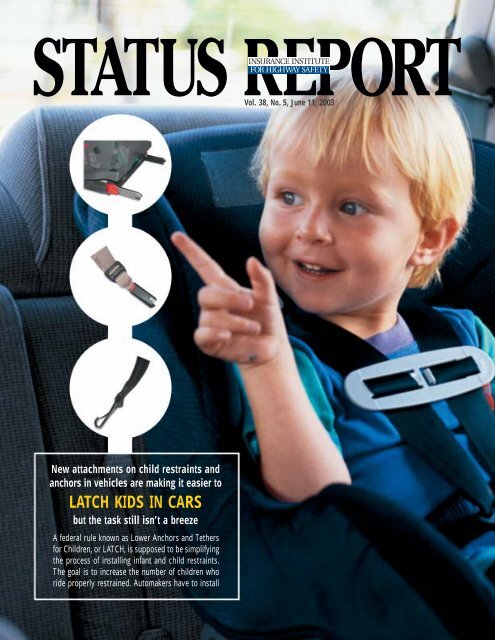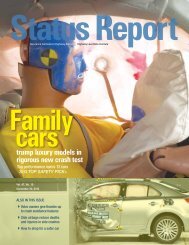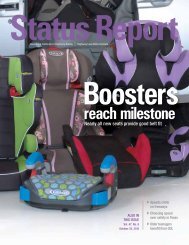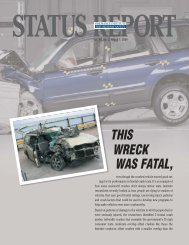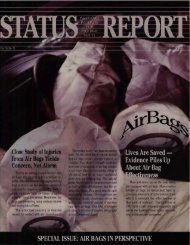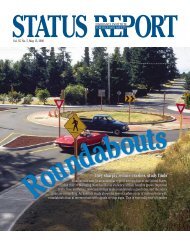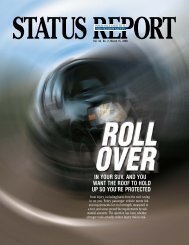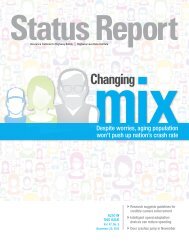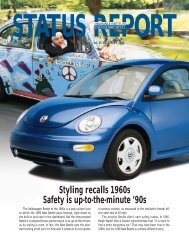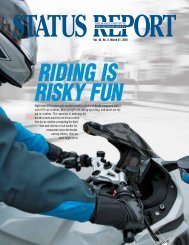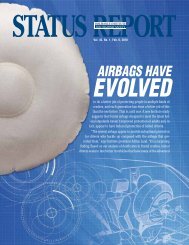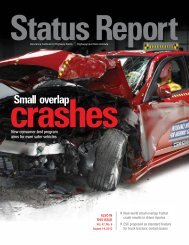Status Report, Vol. 38, No. 5, June 11, 2003 - Insurance Institute for ...
Status Report, Vol. 38, No. 5, June 11, 2003 - Insurance Institute for ...
Status Report, Vol. 38, No. 5, June 11, 2003 - Insurance Institute for ...
- No tags were found...
You also want an ePaper? Increase the reach of your titles
YUMPU automatically turns print PDFs into web optimized ePapers that Google loves.
<strong>Vol</strong>. <strong>38</strong>, <strong>No</strong>. 5, <strong>June</strong> <strong>11</strong>, <strong>2003</strong>New attachments on child restraints andanchors in vehicles are making it easier toLATCH KIDS IN CARSbut the task still isn’t a breezeA federal rule known as Lower Anchors and Tethers<strong>for</strong> Children, or LATCH, is supposed to be simplifyingthe process of installing infant and child restraints.The goal is to increase the number of children whoride properly restrained. Automakers have to install
<strong>Status</strong> <strong>Report</strong>, <strong>Vol</strong>. <strong>38</strong>, <strong>No</strong>. 5, <strong>June</strong> <strong>11</strong>, <strong>2003</strong> 3Installation generallyis easier and lesscomplex with LATCHsystems comparedwith the old way ofrepresent a variety of designs <strong>for</strong> accessingthe anchor points <strong>for</strong> child restraints in theback seats. Both the shapes of the vehicleseats and the placement of the anchors <strong>for</strong>securing the restraints contributed to theease of access.“Installation generally was easier and lesscomplex with LATCH-compliant systemsthan the old way of routing safety beltsthrough child restraints to attach them tocars,” says Susan Ferguson, <strong>Institute</strong> seniorvice president <strong>for</strong> research. “Still, LATCHdoesn’t always make it a simple click-inoperation to install a restraint. Be<strong>for</strong>e buyingone, parents should be sure to try fittingit in the vehicle they plan to use it in becausenot every restraint is going to fit intoevery vehicle.”The easiest fits were in the TrailBlazer,Grand Caravan, and RAV4. In contrast, itwas difficult to secure any of the six childrestraints in the Santa Fe or CTS.The lower anchors in some vehicles arevisible, while in other cases they’rerecessed into the seats. Visible anchorsgenerally made installation easier, but notalways. In the Ford Taurus, which has clearlyvisible anchors, the researchers had difficultyfitting two restraints because the positionof the safety belt buckle impededef<strong>for</strong>ts to tighten the restraint straps.In most cases, child restraints with rigidattachments were among the simplest to installand remove because they don’t have anystraps to tighten. On the other hand, researchersweren’t able to install (continues on p.6)routing safety beltsthrough restraints toattach them to cars.Still, LATCH doesn’talways make it asimple click-inoperation to installa child restraint.
4 <strong>Status</strong> <strong>Report</strong>, <strong>Vol</strong>. <strong>38</strong>, <strong>No</strong>. 5, <strong>June</strong> <strong>11</strong>, <strong>2003</strong>Child restraints: how can they beimproved to save more lives in crashes?The answer is that it won’t be easy. Many fatal crashes involving childoccupants are so severe that better child restraints wouldn’t haveprevented the deaths. These are the conclusions of a new study ofnearly 100 crashes in which children riding in restraints were fatallyinjured. Previous research has shown that child restraints provideexcellent protection, reducing fatality risk by more than 70 percent<strong>for</strong> infants and more than 50 percent <strong>for</strong> toddlers.For the new study, researchers identified crashes from the FatalityAnalysis <strong>Report</strong>ing System in which a child was fatally injured12% grossmisuse ofrestraint33% collision withheavy vehicle16% side impact13% frontal impact50% unsurvivable crash involvingcomplete loss of space around child18% hit stationary object14% collision withcar or minivan34% collision with SUV, pickup, or large van4% ejection4% otherCHARACTERISTICS OF THE FATAL CRASHESDEATHS OF CHILDRENRIDING IN INFANT ANDCHILD RESTRAINTSSTRUCK OR STRIKING VEHICLE OR OBJECTduring 2001 while riding in a child restraint. Then the researchersobtained detailed police reports, often including photos from thecrash sites, and attempted to determine the primary cause of thechildren’s injuries. The idea was to get a better understanding of howchild restraints are per<strong>for</strong>ming in fatal crashes.“<strong>No</strong> one had really looked systematically at police reports to determinethe sources of the fatal injuries,” says Chris Sherwood, researchscientist at the University of Virginia’s Automobile Safety Laboratoryand lead author of the research report. The study was conductedjointly by the <strong>Institute</strong> and the university group.“To find opportunities to improve child restraints, we first have tofind out whether they’re failing and, if so, how,” Sherwood adds.Most of the children who died in the crashes (70 percent) wereage 2 or younger, and they were riding in <strong>for</strong>ward-facing restraints.More than 80 percent of the known fatal injuries were to the head.Of the crashes examined, half were judged unsurvivable. Intrusioninto the vehicle resulted in complete loss of survival space <strong>for</strong> the childrenwho died. Where some space remained around a restrainedchild’s seating position, the researchers considered additional factors.Gross misuse of restraints — either failing to attach them to vehiclesor attaching them too loosely — led to deaths in 12 percent of thecases. Ejection from restraints or contacts with other occupants orcargo accounted <strong>for</strong> another 8 percent. Twenty-nine percent of thecrashes studied (16 percent side, 13 percent frontal) were judged potentiallysurvivable, but it wasn’t clear why the children didn’t survive.Two-thirds of the vehicles in which restrained children died werestruck by heavy commercial vehicles, SUVs, pickup trucks, or vans.This compares with one-third of the deaths of fatally injured childrenwho weren’t in restraints.CHARACTERISTICS OF THE CRASHES IN WHICH CHILDREN DIEDSide impacts accounted <strong>for</strong> more deaths of restrained children thanany other crash configuration. Two-thirds of the vehicles in whichrestrained children died were struck by heavier vehicles includingcommercial trucks, SUVs, pickups, and vans.“These findings confirm that child restraints are doing a verygood job. Most deaths of properly restrained children occur in crashesso severe that there’s really no room left <strong>for</strong> survival,” says SusanFerguson, <strong>Institute</strong> senior vice president <strong>for</strong> research. The severity ofthe crashes studied is apparent from the number of other deaths inthe vehicles in which the children died. In 80 percent of the crashesthat researchers deemed unsurvivable <strong>for</strong> a child, at least one otheroccupant also was killed. This compares with 37 percent of the crashesthat researchers judged potentially survivable.Side impacts accounted <strong>for</strong> the largest number of child deaths(40 percent). Frontal impacts accounted <strong>for</strong> another third of thedeaths. Almost half of the side impacts were deemed unsurvivable,and the remainder involved at least some intrusion into the child’ssurvival space. Only 12 percent of the fatal crashes studied were rear
<strong>Status</strong> <strong>Report</strong>, <strong>Vol</strong>. <strong>38</strong>, <strong>No</strong>. 5, <strong>June</strong> <strong>11</strong>, <strong>2003</strong> 5impacts, but 80 percent of these were considered unsurvivabledue to massive intrusion into the child’s survival space.The misuse of restraints that led to some of the childdeaths could have resulted from well-known installation problems.There’s widespread incompatibility between child restraintsand vehicle seats and between restraints and the safetybelts that have been used to attach them (see <strong>Status</strong> <strong>Report</strong>,Jan. 16, 1999; on the web at www.highwaysafety.org). To reduceincompatibilities, all new restraints and vehicles are required tohave a universal attachment system known as LATCH (see p.1).These requirements “are intended to increase the numberof children who ride properly restrained, and increasingrestraint use still is key to saving lives. It could be more difficultto find effective ways to improvethe restraints,” Ferguson says.A federal standard requires childrestraints to meet per<strong>for</strong>mance requirementsin a 30 mph frontal sledtest. The National Highway TrafficSafety Administration has requestedcomments about options <strong>for</strong> testingrestraints in side impacts. Given thatso many of the child deaths in potentiallysurvivable crashes occurred inside impacts, improving the per<strong>for</strong>manceof restraints in such crashes“should be a priority <strong>for</strong> future upgradesto the standard. This may requiretime because there aren’t yetany side impact test dummies representingchildren. <strong>No</strong>r are there establishedprocedures <strong>for</strong> representingthe intrusion to which child restraintsare exposed in severe side impacts,”Ferguson points out.Head injuries in frontal impactspotentially could be reduced by increasingthe use of top tethers, whichlimit the distance a child travels <strong>for</strong>wardin frontal crashes. This couldprevent facial and head injuries fromcontact with seatbacks or instrumentpanels, but tethers aren’t being widelyused (see p.6).For a copy of “Factors Leading toCrash Fatalities to Children in ChildRestraints” by C.P. Sherwood et al.,write: Publications, <strong>Insurance</strong> <strong>Institute</strong><strong>for</strong> Highway Safety, 1005 N. GlebeRd., Arlington, VA 22201, or emailpublications@iihs.org.NO POTENTIAL FOR SURVIVAL IN MOST OF THE CRASHES IN WHICH CHILDREN DIEDA 3-year-old child in the left rear seat of a station wagon was killed in a frontal crash with a pickuptruck (top). The driver and a 5-year-old passenger also died. In a frontal crash with a large truck(above), the driver of a Nissan Maxima and a 6-month-old child in the front seat were killed. Whena tractor-trailer struck the back of a Nissan Sentra (below), a 1-year-old child in the back seat died.
6 <strong>Status</strong> <strong>Report</strong>, <strong>Vol</strong>. <strong>38</strong>, <strong>No</strong>. 5, <strong>June</strong> <strong>11</strong>, <strong>2003</strong>(continued from on p.3) either of the tworestraints with rigid attachments in theHyundai Santa Fe. The geometry of this vehicle’sback seat was such that the researcherscouldn’t line up the attachments on therestraints with the anchors buried deep inthe vehicle seat, and the inflexibility of theattachments left little room <strong>for</strong> maneuvering.Researchers couldn’t install one of thetwo child restraints with rigid attachmentsin the Cadillac CTS, either.Removal of child restraints also could bedifficult. The release buttons on restraintswith rigid and C-hook attachments madethem easy to remove. Releasing the flexiblehook required depressing it and then rotatingit when the anchor was buried in thevehicle seat.Other problems were associated withtop tethers. Especially in SUVs and minivans,these could be hard to use. Anchors<strong>for</strong> tethers weren’t always clearly marked.Sometimes the anchor points were on thebacks of vehicle seats, which had to be foldeddown be<strong>for</strong>e a tether could be installed.In some cases, a head restraint had to beremoved to accommodate a tether.“Parents need to read two manuals, theone that comes with the restraint and thevehicle owner’s manual, to make installationgo more smoothly, particularly when itcomes to top tethers,” Ferguson says. “Buteven this won’t guarantee success becausethe manuals aren’t always helpful. Forexample, some don’t say what to do when aseatback or head restraint gets in the way.”Head restraints inmany vehicles, including thisHyundai Santa Fe, have to beremoved to install child restraints.WILL TETHERS BE USED? ONLY ABOUT HALF OF THE TIME, SURVEYS SUGGESTFor years some child restraints have included top tethers, but the tethers never have beenwidely used. They were required on child restraints in the early 1980s, but then the NationalHighway Traffic Safety Administration backed away from the requirement. Some automakersdid provide anchors <strong>for</strong> tethers, but use rates still were low. A 1974 <strong>Institute</strong> survey indicatedthat available tethers were being used only about half of the time. What’s new since lastSeptember is that both tethers and corresponding anchors in vehicles are required (see p.1).But use rates don’t appear to be going up. When <strong>Institute</strong> researchers recently surveyedchild restraint use in Maryland parking lots, they found a tether use rate of 47 percentamong <strong>for</strong>ward-facing restraints known to have tethers.Cars that are goodper<strong>for</strong>mers in testsalso protect peoplein real crashesDrivers of vehicles that earn ratings offour stars in the European New Car AssessmentProgram (EuroNCAP) areabout 30 percent less likely to beseverely injured in a crash than driversof cars with one-star ratings. Thisis the main finding of a Swedish studythat compares real-world crash outcomeswith crash test results.EuroNCAP rates cars based on twotests, a 40 mph frontal offset test likethe <strong>Institute</strong>’s plus a side impact. Newcars in Europe earn one to five starsbased on per<strong>for</strong>mance in these tests.Four stars typically is the highest rating.To earn a fifth star, a car must passan additional side-into-rigid-pole test(see <strong>Status</strong> <strong>Report</strong>, Feb. 9, 2002; on theweb at www.highwaysafety.org). <strong>No</strong>neof the cars assessed in the Swedishstudy earned five stars.The researchers examined policereportedinjuries to 12,214 drivers incar-to-car crashes in Sweden over sixyears, comparing the results with vehicles’EuroNCAP ratings. With eachdecrease in rating stars, the severeinjury risk increased significantly.“These findings lend additionalvalidity to programs that rate vehiclecrashworthiness based on the resultsof crash tests,” says <strong>Institute</strong> presidentBrian O’Neill.The study was conducted by researchersat the Swedish NationalRoad Administration and Australia’sMonash University. Similar results arereported in another Monash studyconducted with the <strong>Institute</strong>. Theresearchers compared injury datareported from real crashes withresults of both the <strong>Institute</strong>’s frontaloffset crash tests and the federal government’sfull-front tests. Using crash
<strong>Status</strong> <strong>Report</strong>, <strong>Vol</strong>. <strong>38</strong>, <strong>No</strong>. 5, <strong>June</strong> <strong>11</strong>, <strong>2003</strong> 7Per<strong>for</strong>mancein tests predictsexperience inon-the-roadcrashesdata from three states (Florida, Ohio, andPennsylvania), the researchers found fewerdeaths and police-reported serious injuriesin vehicles with good test ratings.However, the results were not robust,and the strongest correlation between crashtest and real-world crash per<strong>for</strong>mance was<strong>for</strong> nonfrontal crashes. “These weak relationshipslikely reflect the lack of detail andfundamental difference in injury in<strong>for</strong>mationin police crash reports compared to thatused in deriving crashworthiness ratings,”the researchers say.An advantage of the Swedish data wasthat severe injuries were defined as thoserequiring hospitalization. In the U.S. study,they were defined as injuries recorded bypolice as serious. Studies have shown thatmost police-reported serious injuries actuallyare minor, so the Swedish researcherswere better able to identify serious injuriesof the kind measured in the crash tests.However, even the Swedish data didn’tinclude in<strong>for</strong>mation about the types orseverities of specific injuries.O’Neill explains that “detailed data oncrash and injury severities are availableonly <strong>for</strong> a limited number of crashes <strong>for</strong>which special investigations are conducted— <strong>for</strong> example, crashes included in the NationalAutomotive Sampling System. But thesample sizes in these datasets are inadequate<strong>for</strong> studies relating to individual vehiclemodels, so they don’t allow us to saywhether a specific model that earns goodcrash test results also does a good job ofprotecting its occupants in real crashes. Onthe other hand, the much larger samples ofpolice-reported data have their own limitations.They typically include few if any reliabledetails on injury or crash severity.”The Swedish study, “How Do EuroNCAPResults Correlate with Real-Life InjuryRisks?” by L. Lie and C. Tingvall, is in TrafficInjury Prevention 3:288-93. For a copy of“U.S. Consumer Crash Test Results andInjury Risk in Police-<strong>Report</strong>ed Crashes” byS. Newstead et al. write: Publications, <strong>Insurance</strong><strong>Institute</strong> <strong>for</strong> Highway Safety, 1005N. Glebe Rd., Arlington, VA 22201, or emailpublications@iihs.org.
NON-PROFIT ORG.U.S. POSTAGEPAIDPERMIT NO. 252ARLINGTON, VA1005 N. Glebe Rd., Arlington, VA 22201Phone 703/247-1500 Fax 247-1588Internet: www.highwaysafety.org<strong>Vol</strong>. <strong>38</strong>, <strong>No</strong>. 5, <strong>June</strong> <strong>11</strong>, <strong>2003</strong>On the insideLATCH rules are helping, but not solving,child restraint installation problems .........p.1When restrained infants and children die incrashes, it usually isn’t because their restraintsfailed .................................................p.4Top tethers on child restraints were usedonly about half of the time be<strong>for</strong>e LATCH rulesand aren’t in use more often now .................p.6Crash tests predict injury likelihood in realworldcollisions .............................................p.6Contents may be republished with attribution.1 0018-988XIf you want to join the <strong>Status</strong> <strong>Report</strong> mail list,remove your name from it, or change youraddress, email <strong>Status</strong><strong>Report</strong>@iihs.org. Orcall or write the <strong>Institute</strong>.The <strong>Insurance</strong> <strong>Institute</strong> <strong>for</strong> Highway Safetyis an independent, nonprofit, scientific andeducational organization dedicated to reducingthe losses — deaths, injuries, andproperty damage — from crashes on thenation’s highways. The <strong>Institute</strong> is whollysupported by automobile insurers:21st Century <strong>Insurance</strong>Alfa <strong>Insurance</strong>Allstate <strong>Insurance</strong> GroupAmerican Express Property and CasualtyAmerican Family Mutual <strong>Insurance</strong>American National Property and CasualtyAmica Mutual <strong>Insurance</strong> CompanyAuto Club GroupAuto Club South <strong>Insurance</strong> CompanyBaldwin & Lyons GroupBituminous <strong>Insurance</strong> CompaniesCali<strong>for</strong>nia <strong>Insurance</strong> GroupCali<strong>for</strong>nia State Automobile AssociationChubb Group of <strong>Insurance</strong> CompaniesCotton StatesCountry <strong>Insurance</strong> & Financial ServicesErie <strong>Insurance</strong> GroupFarmers <strong>Insurance</strong> Group of CompaniesFarmers Mutual of NebraskaFrankenmuthThe GEICO GroupGeneral Casualty <strong>Insurance</strong> CompaniesGMAC <strong>Insurance</strong> GroupGrange <strong>Insurance</strong>Harleysville <strong>Insurance</strong> CompaniesThe Hart<strong>for</strong>dIdaho Farm BureauIowa Farm BureauLiberty Mutual <strong>Insurance</strong> GroupMerastarMercury General GroupMetLife Auto & HomeMiddlesex MutualMontgomery <strong>Insurance</strong> CompaniesMSI <strong>Insurance</strong> CompaniesMutual of EnumclawNational Grange MutualNationwide <strong>Insurance</strong><strong>No</strong>rth Carolina Farm BureauOklahoma Farm BureauOregon Mutual GroupOrionAutoPalisades <strong>Insurance</strong>Pekin <strong>Insurance</strong>PEMCO <strong>Insurance</strong> CompaniesPreserver GroupThe Progressive CorporationPrudential FinancialResponse <strong>Insurance</strong>Rockingham GroupRoyal & SunAllianceSAFECO Property & CasualtySECURAShelter <strong>Insurance</strong> CompaniesSompo Japan <strong>Insurance</strong> Company of AmericaState Auto <strong>Insurance</strong> CompaniesState Farm <strong>Insurance</strong> CompaniesTokio MarineUSAAVirginia Farm BureauVirginia Mutual <strong>Insurance</strong> CompanyZurich <strong>No</strong>rth America


